JL Cross 23
RSP 11524
Grower: Kevin McKernan
General Information
- Accession Date
- June 17, 2020
- Reported Plant Sex
- not reported
- Report Type
- StrainSEEK v2 3.2Mb
- DNA Extracted From
- Unknown
The strain rarity visualization shows how distant the strain is from the other cultivars in the Kannapedia database. The y-axis represents genetic distance, getting farther as you go up. The width of the visualization at any position along the y-axis shows how many strains there are in the database at that genetic distance. So, a common strain will have a more bottom-heavy shape, while uncommon and rare cultivars will have a visualization that is generally shifted towards the top.
Chemical Information
Cannabinoid and terpenoid information provided by the grower.
Cannabinoids
No information provided.
Terpenoids
No information provided.
Genetic Information
- Plant Type
- Type II
File Downloads
The bell curve in the heterozygosity visualization shows the distribution of heterozygosity levels for cannabis cultivars in the Kannapedia database. The green line shows where this particular strain fits within the distribution. Heterozygosity is associated with heterosis (aka hybrid vigor) but also leads to the production of more variable offspring. When plants have two genetically different parents, heterozygosity levels will be higher than if it has been inbred or backcrossed repeatedly.
The ratio of reads mapped to Y-contigs to reads mapped to the whole Cannabis genome (Y-ratios) has been demonstrated to be strongly correlated with plant sex typing. This plot shows the distribution of Y-ratios for all samples in our database which were sequenced with the same method (panel or WGS) as this sample and where this sample falls in the distribution.
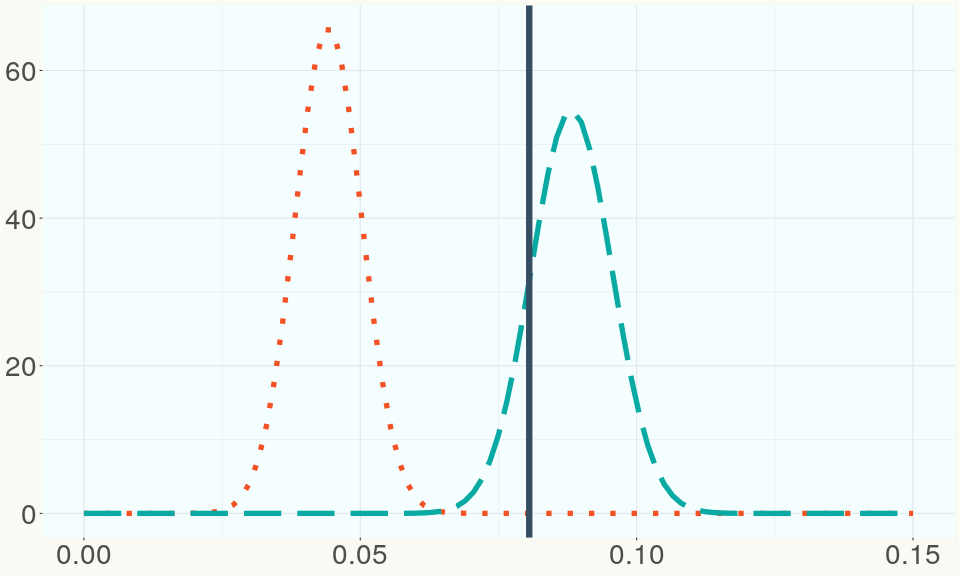
This chart represents the Illumina sequence coverage over the Bt/Bd allele. These are the three regions in the cannabis genome that impact THCA, CBDA, CBGA production. Coverage over the Active CBDAS gene is highly correlated with Type II and Type III plants as described by Etienne de Meijer. Coverage over the THCA gene is highly correlated with Type I and Type II plants but is anti-correlated with Type III plants. Type I plants require coverage over the inactive CBDA loci and no coverage over the Active CBDA gene. Lack of coverage over the Active CBDA and Active THCA allele are presumed to be Type IV plants (CBGA dominant). While deletions of entire THCAS and CBDAS genes are the most common Bt:Bd alleles observed, it is possible to have plants with these genes where functional expression of the enzyme is disrupted by deactivating point mutations (Kojoma et al. 2006).
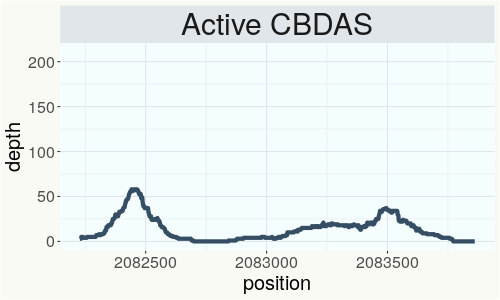
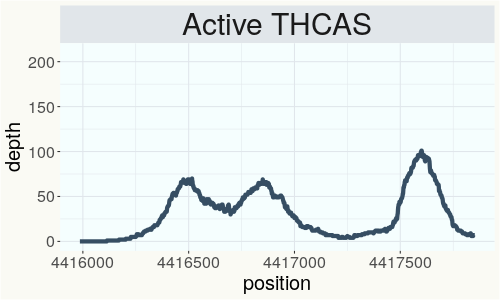
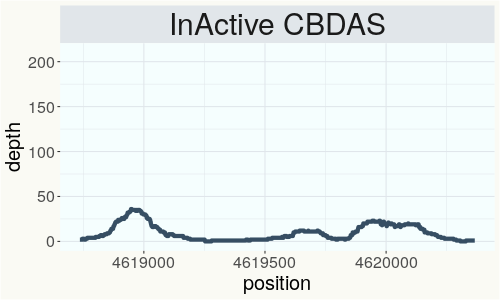
This chart represents the Illumina sequence coverage over the CBCA synthase gene.
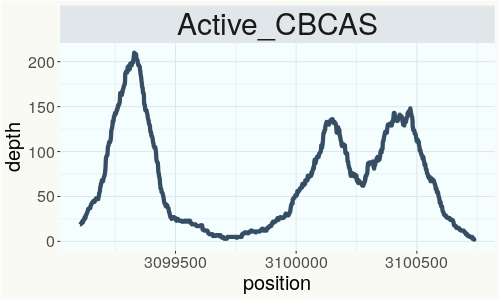
Variants (THCAS, CBDAS, and CBCAS)
Variants (Select Genes of Interest)
| PKSG-2a | c.67T>A | p.Phe23Ile | missense variant | moderate | contig700 | 1945567 | A/T | |
| PKSG-2a | c.31A>T | p.Thr11Ser | missense variant | moderate | contig700 | 1945603 | T/A | |
| PKSG-2b | c.1152T>A | p.Asn384Lys | missense variant | moderate | contig700 | 1950486 | A/T | |
| PKSG-2b | c.1132C>G | p.Leu378Val | missense variant | moderate | contig700 | 1950506 | G/C |
|
| PKSG-2b | c.1117A>G | p.Ile373Val | missense variant | moderate | contig700 | 1950521 | T/C | |
| PKSG-2b | c.774G>A | p.Met258Ile | missense variant | moderate | contig700 | 1950864 | C/T | |
| PKSG-2b | c.31A>T | p.Thr11Ser | missense variant | moderate | contig700 | 1951851 | T/A | |
| DXR-2 | c.1319T>C | p.Ile440Thr | missense variant | moderate | contig380 | 285250 | A/G |
|
| FAD2-2 | c.62C>T | p.Pro21Leu | missense variant | moderate | contig83 | 1803307 | G/A |
|
| FAD2-2 | c.23G>A | p.Ser8Asn | missense variant | moderate | contig83 | 1803346 | C/T |
|
| aPT4 | c.97T>C | p.Tyr33His | missense variant | moderate | contig121 | 2828753 | T/C |
|
| aPT4 | c.153A>C | p.Lys51Asn | missense variant | moderate | contig121 | 2828809 | A/C |
|
| aPT4 | c.198A>C | p.Lys66Asn | missense variant | moderate | contig121 | 2828854 | A/C |
|
| aPT4 |
c.235_236del |
p.Val79fs | frameshift variant | high | contig121 | 2829030 | ATG/A |
|
| aPT4 | c.238delT | p.Ser80fs | frameshift variant | high | contig121 | 2829034 | AT/A |
|
| aPT4 | c.1168T>C | p.Tyr390His | missense variant | moderate | contig121 | 2833503 | T/C |
|
| aPT1 |
c.95_97delGT |
p.Cys32del | disruptive inframe deletion | moderate | contig121 | 2835800 | ATGT/A | |
| aPT1 | c.406A>G | p.Ile136Val | missense variant | moderate | contig121 | 2839605 | A/G | |
| HDS-2 |
c.82_93delGT |
p.Val28_Thr3 |
conservative inframe deletion | moderate | contig95 | 1989748 |
CGTAACCGGAAC |
|
| HDS-2 | c.127T>G | p.Ser43Ala | missense variant | moderate | contig95 | 1989794 | T/G |
|
Nearest genetic relatives (All Samples)
- 0.058 JL Tent 4 (RSP11491)
- 0.062 JL X NSPM1 7 (RSP11469)
- 0.072 JL x NSPM1 1 5 (RSP11479)
- 0.078 JL X NSPM1 21 (RSP11474)
- 0.081 JL Cross 9 (RSP11510)
- 0.084 JL X NSPM1 5 (RSP11467)
- 0.084 JL x NSPM1 3 (RSP11481)
- 0.088 JL X NSPM1 14 (RSP11473)
- 0.089 JL X NSPM1 30 (RSP11476)
- 0.090 JL Cross 19 (RSP11520)
- 0.090 JL Tent 2 (RSP11489)
- 0.091 JL Cross 21 (RSP11522)
- 0.095 JL Tent 3 (RSP11490)
- 0.097 JL Tent 1 yellow stake (RSP11488)
- 0.100 JL Cross 15 (RSP11516)
- 0.109 JL Cross 17 (RSP11518)
- 0.113 JL Cross 18 (RSP11519)
- 0.118 JL X NSPM1 22 (RSP11475)
- 0.118 JL X NSPM1 33 (RSP11477)
- 0.121 JL Cross 26 (RSP11527)
Most genetically distant strains (All Samples)
- 0.458 Cbot-2019-005 (RSP11133)
- 0.453 80E (RSP11213)
- 0.448 BagSeed (RSP12627)
- 0.440 Northern Lights (RSP11501)
- 0.433 80E (RSP11212)
- 0.432 CS (RSP11208)
- 0.428 Ruderalis Indica (SRR14708267)
- 0.424 80E (RSP11211)
- 0.423 BagSeed (RSP12501)
- 0.418 RKM-2018-024 (RSP11116)
- 0.418 Arcata Trainwreck (RSP11176)
- 0.416 R1in136 (SRR14708226)
- 0.416 Carmaleonte (RSP11207)
- 0.413 R1in136 (SRR14708227)
- 0.412 IUP3 (SRR14708256)
- 0.411 R1in136 (SRR14708237)
- 0.410 IUP2 (SRR14708257)
- 0.409 Feral (RSP11205)
- 0.408 Carmagnola (RSP11202)
- 0.407 R3in134 (SRR14708218)
Nearest genetic relative in Phylos dataset
- Overlapping SNPs:
- 71
- Concordance:
- 50
Nearest genetic relative in Lynch dataset
- Overlapping SNPs:
- 6
- Concordance:
- 6
Blockchain Registration Information
- SHASUM Hash
-
a6dadeba13cf271b3596208cf7041bee 8b9f113b44d05504 153dd294f137e2cd